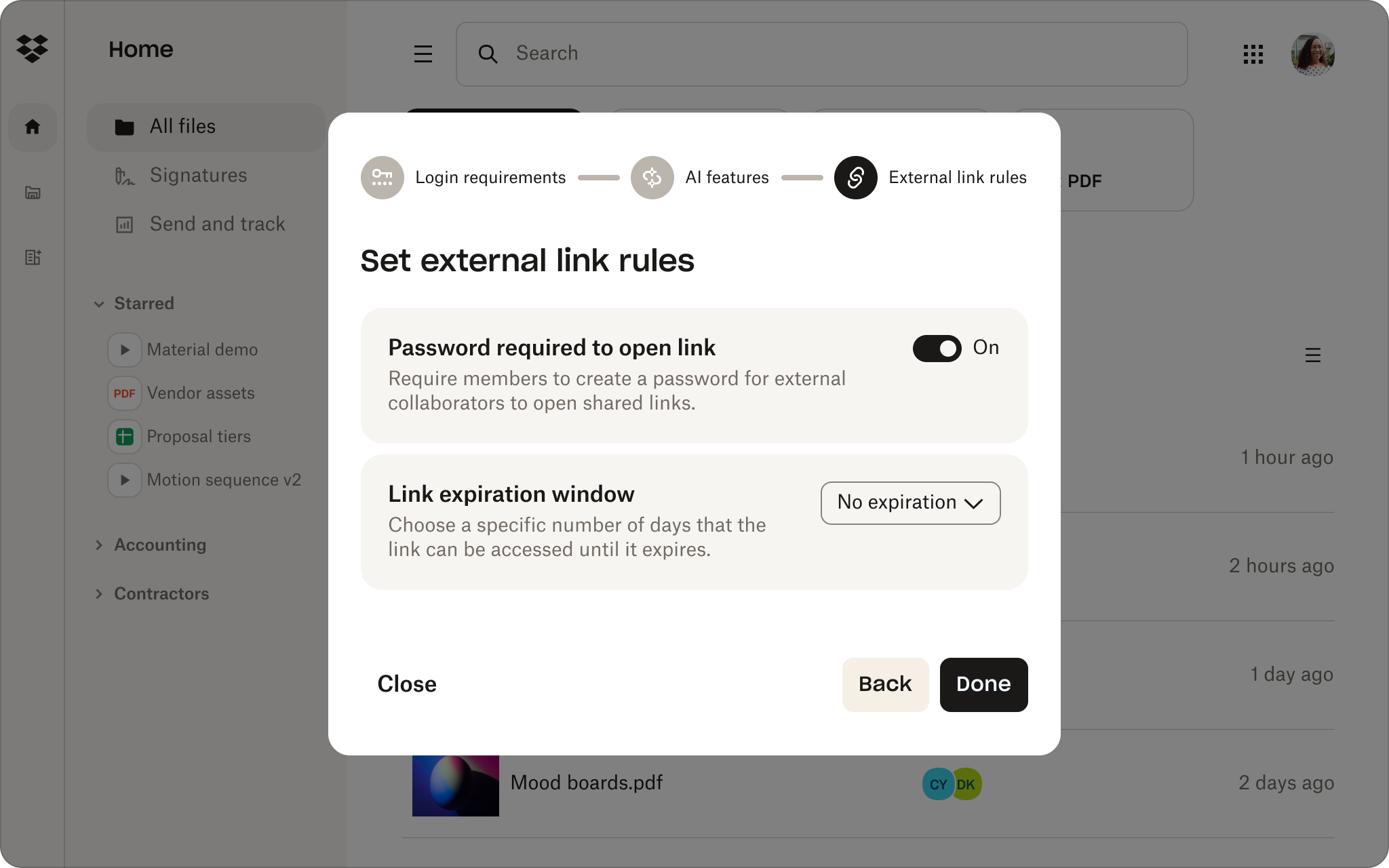It’s not bad guys with flashlights thumbing through a filing cabinet anymore. Today, someone can see, steal, or destroy information in a flash. The threat is very real for stuff like financial data, but also the personal information of customers.
Password protection is nothing new, but plenty of companies don’t do it right. You can encrypt documents or spreadsheets in your office suite—but what about unfamiliar files or folders?
Image, video, graphics files, and database file formats don’t have the same protection. But, put them in your Dropbox account and set the files as password protected—and it’s already done.
In this guide, we’ll explain how you can secure your files with password protection on a Mac, on a Windows computer, or on any device with Dropbox. But first, let’s look at why it’s so important to password protect files.
Why should I password protect my files?
Reasons to password protect your files include everything from saving yourself from embarrassment and having to make an awkward call, to losing your business’s competitive edge. If you don’t, here are a few problems you might have:
- Loss of advantage: If business plans, product ideas, marketing strategies, or financial data get into the wrong hands, they can be used against you. Adding a password can give you the upper hand.
- Loss of trust: Would you give your details to a company that doesn’t protect personal information, even just a simple address? Neither would we—and neither would your customers.
- Accidents: A typo in an email address, a foolishly mis-shared link, and other flubs can happen innocently—but if you password protect a file, most errors are moot.
- Device compromise: You can’t just rely on your device password to keep your data safe. When you password protect Dropbox files, you add a layer of security across the full business.
- Compliance failure: It’s easy to fall afoul of regulatory bodies via lax security, which can have consequences for your business, like fines or even legal action. Passwords hedge against this.
A report in the Harvard Business Review says breached companies underperform on the NASDAQ by 11.9% after 2 years—so the economic drive for data security and password protection is clear.
There are tons of reasons to password protect your files, but the crucial business reason is it can help protect your finances and reputation, too.
How to password protect files or folders on Windows
You can password protect files like Microsoft Word documents in your office suite on a Windows computer. There are some instructions from Microsoft, which state the following:
- Open your document, select File > Info > Protect Document > Encrypt with Password.
- Enter a password, then enter it again to confirm.
- Save your file to ensure the password is set.
You can also set a password for folders on Windows using the following steps:
- Right-click on the folder in Windows Explorer.
- Select Properties.
- Go to General, then click the Advanced button under the Attributes section.
- Tick Encrypt Contents to Secure Data.
- Go back to your folder and you’ll see a small yellow lock on each file icon.
Your folder will now be password protected. This works on an account level, so while using Windows your files are automatically decrypted.
Using Windows to password protect files or folders may have some drawbacks compared to using Dropbox. The password protection is limited to the specific Windows computer and account, making it less effective for accessing files from different devices or sharing them. Unauthorized access to your Windows account can also bypass the password protection, compromising file security.
However, despite these drawbacks, Windows' password protection can still be sufficient for simple non-complex tasks.

How to password protect files or folders on a Mac
You can password protect files on plenty of apps like Notes, Pages, and Numbers. To password protect a file on a Mac, open your file, then try the following within the app:
- Select the File menu in the top left corner of your screen.
- Select Set Password.
- Fill in the information, then click Set Password.
You can also password protect folders on a Mac with the following instructions:
- Open Disk Utility from your Applications folder.
- Go to File, then click New Image > Image from Folder.
- Select the folder you want to password protect.
- Click Choose.
- Type a filename and pick a location for the .dmg file, then select either 128-bit AES encryption or 256-bit AES encryption.
- Click Save.
- Enter a password and verify it.
- Click Choose.
- You can also click the key icon to let macOS create a strong password for you.
- In the Image Format dropdown, select read/write—this lets you add or remove files later.
- Click Save, and let Disk Utility encrypt the folder.
The protected disk image is in the location you picked. Open the .dmg file and enter the password to access the folder—where you can manage its contents. Delete the initial folder if you wish.
As with Windows, there are similar drawbacks to password protection on Mac. Robust security features in Dropbox make it the perfect option if you're unsure how to protect any file, folder, or sensitive information. And it's easy to do so on different devices or operating systems, right from your Dropbox account.
Fast, simple, and powerful password protection with Dropbox
The above tips for a Mac or Windows device are great if you need to know how to password protect a file or folder on your local machine. But what if you want to store that data elsewhere or share it with someone else? What on earth do you do? Well, you can protect or share all types of files or folders in Dropbox in a way Windows and Mac just can’t.
It’s easier with Dropbox. Not just for storage or syncing, but for keeping your data secure and under your control—wherever it is. Here’s how Dropbox helps you manage and handle sensitive data:
- Add password protection to any file: Before you share a link to a folder or file, simply set a password for it to control who sees your information. Before anyone can view or download a file, they need to enter the password.
- Two-factor authentication: It’s easy to add 2FA for your Dropbox account, which gives you the best level of protection for anything you might store there.
- Set permissions on links: Dropbox makes it simple to set permissions, add passwords, and set expiration dates on links so you can precisely control file access across your entire organization.
To password protect a file on dropbox.com:
- Hover over the name of the file and click Share.
- Click Settings.
- Click either Link for editing or Link for viewing, depending on which link you’d like to add a password to.
- Next to Require password, toggle it to On.
- Set your file password.
- Click Save.
Dropbox gives you levels of security, where passwords are just one part of a multi-pronged defense.

Control who sees what with password protection for any file
Anything you store in Dropbox already has several layers of protection, and adding password protection lets you build a wall within a wall for precise control over all of your files.
Whenever you upload content, share a file, or share a folder using Dropbox, there’s an option to add a password. It’s simple to do it on any device or operating system—all within your account in just a few clicks.


